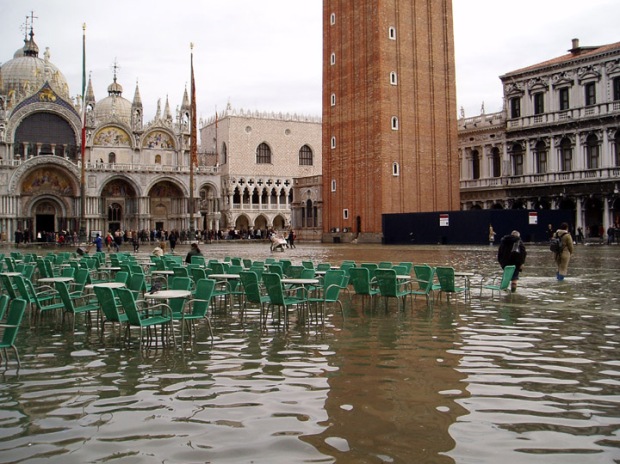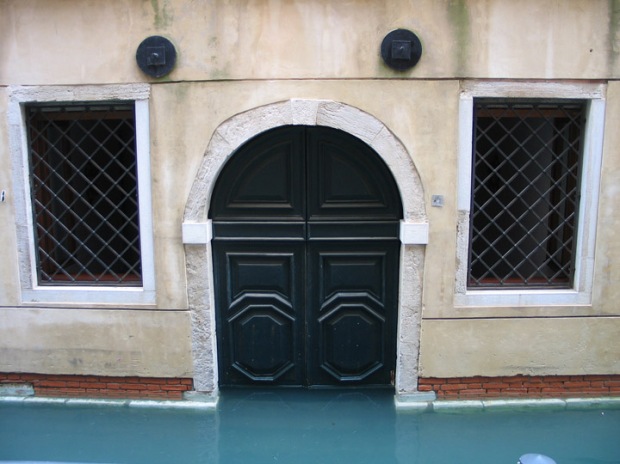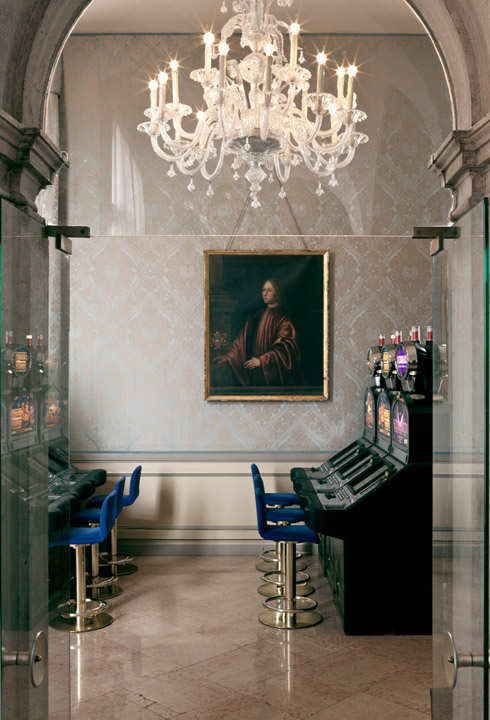Threatened Venice: Why You Need to Visit Now

Happy 2014! Ready for another exciting year of the ArtSmart Roundtable? Of course! This group brings together some of the best art-focused travel blogs to post on a common theme each month. To wish you all a happy New Year, this month we’re focusing on Art to see in 2014! Check out all of the ArtSmart posts below.
While I’m sure my friends are taking a very optimistic interpretation of this month’s topic, it actually got me thinking, “What do I need to see now before it is gone?” This last year brought us the destruction of UNESCO World Heritage sites in Mali, rising tides encroaching on Pacific Islands, further decay at Pompeii and threats to the archaeological sites in Egypt due to on-going political turmoil. There is a distinct possibility that our human actions (whether environmental or political) will destroy magnificent works of art and history critical to our cultural heritage. I can think of one complicated and threatened city that deserves a visit before it changes irrevocably. If you haven’t been, now is the time to see Venice. Hopefully you will see how beautiful and timeless the city is and can become an advocate for its preservation.
Why Venice?
A fantastic city in its conception, this medieval settlement has constructed on a few marshy islands in a shallow lagoon. Residents drove logs into the ground to support the ever growing architecture creating an improbable but secure community offshore. Prosperous trade and shrewd political moves orchestrated by the mighty (but elected) Doge made Venice a supreme Europe power during the Renaissance. This period gave rise to fantastic residences, elegant public buildings and glorious churches. This age also produced greats artists like Giorgione, Veronese, Titian, Tintoretto, and the Bellini Family.
With the opening of the American and Asian ocean trade route, Venice’s economy stagnated and the city lost much of its power and influence. Years of decadence and frivolity followed and through the 18th century Venice declined into essentially a party stop for Grand Tour visitors. Today the once magnificent homes are too expensive for most Italians to maintain and so the resident population has declined dramatically.

A masquerade party in Venice. Follower of Pietro Longhi, “Casino (Il ridotto)”, 18th century, Rijksmuseum, Amsterdam
While a shadow of its former self, the network of small canals and bridges and the magnificent architecture is still too beautiful to miss. Venice has an evocative mystery and allure unlike any other city in Europe that must be experienced. However, physical Venice is under serious threat and now may be the best time to soak in the spirit of the city before it is lost.
Threatened by Climate Change
As a low lying community, Venice has always been impacted by exceptionally high tides. From Autumn to Spring, the city experiences seasonal high tides, known as acqua alta, or “high water”. The city can sustain tides up to 90cm over sea level, but flooding is rapid and extensive above this amount. Half of the city is flooded by 140cm tides and about 80% of the city is submerged by 190cm tides. While these floods have historical precedence dating from the 12th century, they have grown more common and to higher levels in the last decade due to climate change. The increasing sea levels means even more water spills into Venice, thus flooding shops and destroying buildings.

San Marco Square in Venice flooded by the high tide (Photo: Wikipedia)
The Italian government understands the danger to Venice from increasing tides and is working on a highly technical solution. The “MOSE” project will install massive barriers at the three inlets to the Venice lagoon. These dykes can be deployed or dropped depending on the tide and are intended to maintain a steady sea level at all time of the day and year. The project was first conceptualized in the 1960’s, proposed in 2003 and is now under construction. Critics assert that the barriers will not be enough or will cause significant environmental damage by themselves. It remains to be seen if the project can prevent future damage to the city.

Ground floor flooding damages the centuries old residences in Venice. (Photo: Gwenael Piaser)
Commercial Sponsorship, or How the “Cure” Could Kill the Patient
Art collections, wonderful buildings and archaeological sites are almost a natural resource in Italy. Visitors flock to Italy every year to see the Uffizi, Vatican and Pompeii among other places. In 2011, tourism directly accounted for 3.5% of the Italian economy, or 51 billion Euros. But following the recession of the last decade, how can Italy (or any country) afford to pay for massive but necessary restorations to historical and cultural sites like Venice?
One answer could be sponsorship. Corporations have committed to several projects in Italy already. For example, Fendi has stepped in to repair the iconic Trevi Fountain in Rome after the Italian government said they couldn’t afford the project. The Diesel clothing brand is paying $6.7 million to fix the Rialto Bridge, a critical and lovely part of Venice. While these companies may be motivated by charitable intentions and a desire to preserve Italy, they will certainly want something in return and may be seeking out connection to iconic art as a branding opportunity. These partnerships will likely bring advertisement on a massive scale to Venice.
In many ways it is easier to find sponsorship for massive churches and public spaces, but it the residence in Venice that badly need repairs. Soaring costs have driven many residents from Venice with their historic homes going in many cases to rich foreigners. Absent landlords or owners shirking the upkeep on their 17th century homes has meant many of the once beautiful residences all falling into disrepair without any legal recourse to enforce upkeep. Some building, including palaces that once were actually casinos, have been resurrected by developers as casinos, rental properties or other commercial spaces. This is a tenuous road to restoration of the city because it prioritizes profit and is driven by market need rather than an artistic or historical obligation.
With advancing commercial development, fans of Venice must continue to ponder the authenticity of the city. It would be very easy for Venice to become a caricature of itself – a hollow, gaudy shell of its former historic glory or a kind of fabricated cultural “Disneyland”. Citizen preservation societies (notably Save Venice) continue to champion for authenticity and preservation. Caretakers of the city in a way, past and future visitors can advocate for historically sensitive and tasteful, rather than overtly commercial, restoration.
How to Visit Venice Now
The majority of visitors to Venice are day-trippers from the mainland or from a cruise ship. To really appreciate the beautiful and quiet enchantment of Venice, you should spend a few nights in the city. I found the early morning and sunset hours to be so lovely. I could walk the streets, canals and small piazzas almost alone regardless of how busy things had been that day. The shoulder seasons month of April and October are wonderful months to visit. The weather is pleasant and day-time crowds are not so bad.
Definitely stay in Venice a few nights and rent an apartment. The privacy and isolation makes it feel like you are living in the city rather than just visiting. I stayed in a hotel that owned a second building of rooms a few blocks away. I had my own key to the building which gave my stay a sense of belonging to the city.
You can see St. Mark’s Church and the Doge’s Palace in one day but you would be missing out on the most enchanting sight of all – Venice itself. There are so many streets to explore and treasures to find, the city really deserves a few days to soak in its incredibly unique character. The fragility of Venice reminds us of the importance of travel and visit amazing cities while we still can.
For the rest of the January ArtSmart Roundtable, see:
- Erin of A Sense of Place – 5 2014 Shows Not to Be Missed in Boston
- Murissa of the Wanderful Traveler – Top 5 Museum Visits in 2014: From Vancouver to Venice
- Lesley of the CultureTripper – Reopening of the Mauritshuis, The Hague
- Jenna of This Is My Happiness – Art Exhibitions to Catch in 2014
- Ashley of No Onions, Extra Pickles – 2014 Art Worth Traveling for in the USA
- Alexandra of ArtTrav – What art to see in Florence in 2014
And don’t forget to “like” our group on Facebook for art & travel news!












This makes me so sad.
I think the biggest issue (besides climate change) is the urge to turn historical sites into rental facilities. You lose so much of the feeling of the place when you’ve seen it as a backdrop for a bazillion parties/weddings. Plus it’s so hard to preserve to original structure with the foot traffic, photography, and general wear and tear caused by hosting events.
LikeLike
I definitely agree and understand why this is such a difficult problem to solve. Sites have to manage the need to preserve with the need to get enough revenue to continue to operate. In addition to physical preservation, I always worry (especially for Venice) about the “spiritual” preservation of the place. Its a lot easier for well meaning groups and corporations to mess that up.
LikeLike
Wow. So true, Christina. Art and sites to see before they disappear:( Venice is one of my favorite cities and with the extraordinary tourist loads it currently receives it’s increasingly difficult to enjoy. My last visit there, its mystery and allure were almost completely veiled by an impenetrable wall of jostling bodies in most places. I can’t wait for the cruise ships to be banned. Their passengers will be bussed in, I’m sure, but at least it’s a step in the right direction for the lagoon.
LikeLike
Thanks Lesley! You bring up a good point about the cruise ship passengers which I didn’t even touch on in this article. In addition to climate change, neglect and commercial take-overs, tourists themselves can cause damage to Venice. While I don’t like the idea of limited entries into the city, Venice is a historical place and not a theme park. It does not have the infrastructure to handle a blast of land and now sea day-trippers. While I would like to see sufficient docking/embarkation fees to defray the city costs, my only advice for now is to visit during the shoulder or off-season and to enjoy the miraculous late afternoon and twilight hours when they are gone.
LikeLike
Such an evocative post my friend, you certainly have given all of us plenty to think about. I am so happy you mentioned Save Venice because they’ve been a MAJOR influence in the ongoing restoration of Venice and hopefully will continue to do so in the years to come. I was fortunate enough to spend five glorious days in this city and even experienced acqua alta too!! While a little inconvenient at the time especially when our server asked us to hurry our meals so he could close the restaurant due to the rising water 10 feet away from where we were seated. Then the adventure began. We had to find a most circuitous route back to Costello where we were staying and at times, had to remove our shoes and socks to wade through the water. I loved every minute of it. Thank you taking me back to one of my favorite cities in the world…unlike any other in the world!
LikeLike
A great overview of the challenges Venice faces, Christina. We’ve only day-tripped to Venice, but I would love to experience it as you did by staying in apartment for an extended period of itme. In fact, I just happened upon a book here in our apartment lobby that has piqued my curiosity called Venice is a Fish. If things slow down enough, I might just have to dive in. Somehow, it just seems more fitting to pick up some Croatian literature though. 🙂
LikeLike
While it looks like you are having an amazing time in Croatia, I hope you can make it to Venice for a couple days. You experience of staying in the city in an apartment will be quite different from the day-trip you did. 🙂
LikeLike